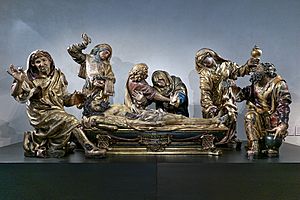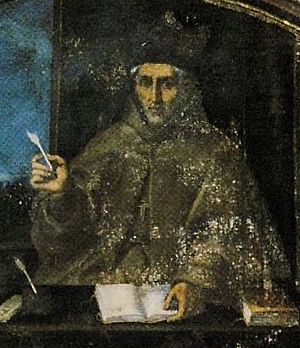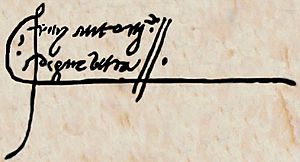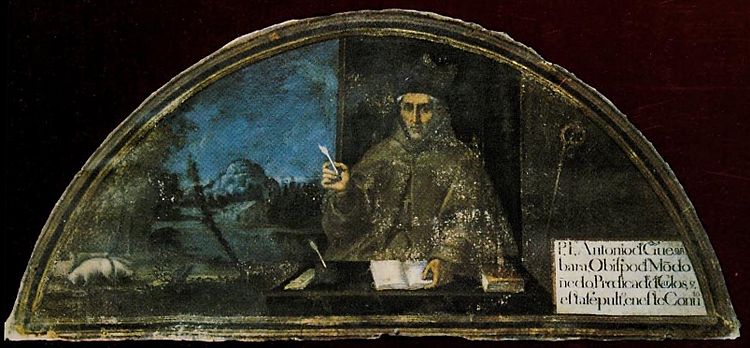Antonio de Guevara facts for kids
Antonio de Guevara (born around 1481 – died April 3, 1545) was an important Spanish bishop and writer. In 1527, he became the official historian for King Charles V. His first book, Libro áureo, was first printed without his permission in 1528. This book, which mixed real history with made-up stories and letters from the life of Marcus Aurelius, became incredibly popular. It was later expanded and called Relox des principes.
This book was translated into almost every language in Europe. A scholar named Méric Casaubon even said that no book, except the Bible, was translated as often as Guevara’s Relox de principes, or Dial of Princes. Besides this famous book, Guevara wrote eight other books. Some of these were still being translated and reprinted even centuries later.
Biography
Antonio de Guevara was born in Treceño, a town in Cantabria, Spain. He spent some of his younger years at the court of Queen Isabella I. In 1505, he joined the Franciscan religious order.
Over time, he held many important jobs for King Charles V. He was the king's preacher and his official historian. He also became a bishop in two different places: Guadix and Mondoñedo. He was also a trusted advisor to King Charles V. Guevara traveled with the king on his trips to Italy and other parts of Europe.
His most famous work is The Dial of Princes (or Reloj de príncipes in Spanish). It was published in Valladolid in 1529. Guevara said it took him eleven years to write. This book was a "mirror for princes," which means it was a guide for rulers. It was written like a teaching story, showing the life and character of an ancient Roman prince, Marcus Aurelius. This prince was known for his wisdom and good qualities.
The Dial of Princes was reprinted many times in Spanish. It quickly became famous, and by the end of the 1500s, it was translated into Latin, Italian, French, German, Dutch, and English. The first English translations were made by Lord Berners and later by Thomas North. An earlier version of this book, called Libro Aureo, appeared in 1528.
The book caused some debate because Guevara claimed it came from an old manuscript he found. Many people thought he had made up this story.

Guevara wrote other important books. In 1539, four of his works were published together. These included Década de los Césares, which told the lives of ten Roman emperors. He also wrote Epístolas familiares, which were like personal letters. Another book was Libro de los inventores del arte de marear, about the art of sailing. Finally, Aviso de privados y doctrina de cortesanos discussed what it was like to be a courtier, someone who advises a king or queen. In this book, Guevara talked about the duties of people who worked for the king. He compared their lives to those in religious orders.
Antonio de Guevara died in Mondoñedo. He was the cousin of Diego de Guevara.
Criticism and Legacy
How people viewed Guevara’s writings changed over time. First, his books were very popular across Europe, especially in the mid-to-late 1500s. Then, people started to criticize his work. They said his writing style was not good and that he used made-up facts or historical references. Because of this, his books were not valued as much.
However, in the 1900s and 2000s, scholars rediscovered his work. They began to see his importance and value his writings more positively.
One of the main criticisms against Guevara was that he took liberties with history in his "pseudo-histories." For example, Pedro de Rhúa wrote letters to Guevara, saying he was upset that Guevara wrote "fables as history." A famous writer named Pierre Bayle also had a negative view of Guevara's work. Bayle said that Guevara was a good speaker but not a good writer. He criticized Guevara for making up historical details. Bayle even said that if the French were wrong for valuing such a book, the Spanish, who valued it even more, deserved to be laughed at.
Despite these criticisms, studies on Guevara grew a lot in the 20th century. Many books have been written about him, arguing for his importance. Today, many of Guevara's complete works are available online for free. Scholars continue to study and discuss his life and writings.
Works
- Libro áureo de Marco Aurelio (Seville, 1528)
- Reloj de príncipes (Valladolid, 1529)
- Las obras del illustre señor don Antonio de gueuara (Valladolid, 1539), which includes:
- Una década de Césares: Lives of ten Roman emperors.
- Aviso de privados y doctrina de cortesanos: Advice for courtiers.
- Menosprecio de corte y alabanza de aldea: Dislike of court and praise of country life.
- Arte del Marear y de los inventores de ella: The art of navigation and its inventors.
- Epístolas familiares (1539, 1541): Personal letters.
- Oratorio de religiosos y ejercicio de virtuosos (Valladolid, 1542): A guide for religious and virtuous living.
- Monte Calvario, parts 1 and 2 (1545, 1549): A religious work.
English Translations
- The Golden Boke of Marcus Aurelius Emperour, translated by John Bourchier, Lord Berners (London: Thomas Berthelet, 1534). Also reprinted in 1559, 1566, 1586.
- A dispraise of the life of a courtier, and a commendacion of the life of the labouryng man, translated by Sir Francis Bryan (1548).
- The Diall of Princes, translated by Thomas North (London: John Waylande, 1557; republished as The Dial of Princes, London: Richarde Tottill and Thomas Marshe, 1568).
- The Favored Courtier, translated by Edward Hellowes (1563).
- A Looking Glasse for the Court, translated by Sir Francis Bryan and Thomas Tymme (London: William Norton, 1575).
- The familiar epistles of Sir Anthony of Gueuara, preacher, chronicler, and counceller to the Emperour Charles the fifth, translated by Edward Hellowes (London: Ralph Newberry, 1575?).
- A chronicle, conteyning the liues of tenne emperours of Rome, translated by Edward Hellowes (London: Ralph Newberrie, 1577).
- A booke of the inuention of the art of nauigation and of the greate trauelles whiche they passe that saile in Gallies, translated by Edward Hellowes (London: Ralph Newberry, 1578).
- The Mount of Caluarie, (London: Printed by A. Islip for E. White, 1595).
- Mount Caluarie, the Second Part, (London: Printed by A. Islip for E. White, 1597).
- Archontorologion : Or The diall of princes: containing the golden and famovs booke of Marcvs Avrelivs, sometime emperour of Rome, translated by Sir Thomas North (London: B. Alsop, 1619).
- Spanish Letters: Historical, Satyrical, and Moral, translated by John Savage (London, 1697).
- The mysteries of mount Calvary, translated by Rev. Orbley Shipley (London: Ribingtons, 1868).
- A Looking Glasse for the Court, translated by Sir Francis Bryan and Jessica Sequeira. Seattle, WA: Sublunary Editions, 2021.
See also
 In Spanish: Antonio de Guevara para niños
In Spanish: Antonio de Guevara para niños




